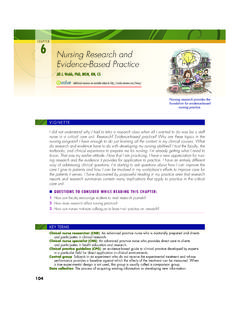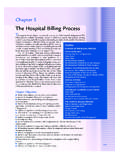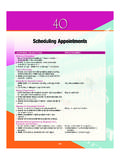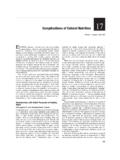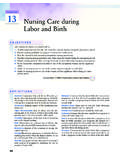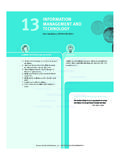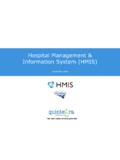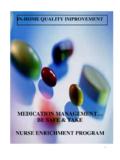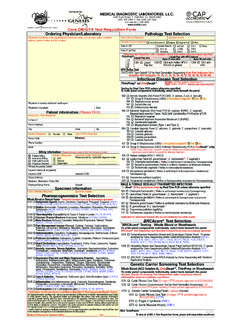Transcription of Hospital Billing and Coding Process - Coursewareobjects.com
1 Ch 2/6/06 5:51 PM Page 85. SECTION TWO. Hospital Billing and Coding Process Patient Accounts and Data Flow in the Hospital The Hospital Billing Process Accounts Receivable (A/R) management Ch 2/6/06 5:51 PM Page 87. 87 Section One: Section Title Chapter 00: Chapter Title 87. Chapter 4. Patient Accounts and Data Flow in the Hospital The purpose of this chapter is to provide a basic under- standing of the patient care Process and how data flow within a Hospital from the time a patient is admitted to when charges are Outline submitted for patient care services. The flow of information is a PATIENT ACCOUNTS DATA FLOW. critical factor in providing efficient patient care and Billing for Outpatient services rendered during the patient visit. The Process of Ambulatory Surgery admitting, treating, discharging, and Billing patient care services Inpatient requires various departments to perform specific functions simultaneously.
2 One function is to document all information PATIENT ADMISSION. regarding patient care services including the patient's condition, Preadmission Testing disease, injury, illness, or other reason for treatment. Designated Utilization Review (UR). personnel within each department are responsible for docu- Admission Evaluation Protocol (AEP). menting patient care services in the patient's medical record. Peer Review Organization (PRO). Patient care services are coded and charges are entered by THE PATIENT CARE Process . specified personnel in various clinical departments and by the THE ADMISSIONS Process . Health information management (HIM) Department. Patient Interview Patient charges are submitted to patients and third-party Patient Registration payers after the patient is discharged. The concepts presented in Utilization Review (UR). this chapter are critical to understanding the Hospital Billing and Insurance Verification claims Process , which will be discussed in the next chapter.
3 Patient's Medical Record (Chart). Room/Bed Assignment Chapter Objectives Admission Summary (Face Sheet). Census Update Define terms, phrases, abbreviations, and acronyms related to patient accounts and data flow. MEDICAL RECORD DOCUMENTATION. Demonstrate an understanding of patient accounts and data Purpose of Documentation flow for outpatient, ambulatory surgery, and inpatient services. Content of th Patient's Medical Record Define patient admission and discuss procedures required PATIENT CARE SERVICES. to ensure quality of patient care. Common Categories of Hospital Services and Items Outline the patient care Process and provide an explanation of each component. CHARGE CAPTURE. Demonstrate an understanding of the admission Process Charge Capture Procedures and forms utilized during the Process . Hospital Charges Provide an explanation of the insurance verification Process .
4 PATIENT DISCHARGE. Describe the relationship between the admission Process and Billing for patient services. HEALTH information management (HIM). Discuss the purpose of medical record documentation and PROCEDURES. various forms and documents used in the medical record. THE Hospital Billing Process . Demonstrate an understanding of patient care services Charge Submission provided by a Hospital . Patient Transactions Provide an explanation of how charges are captured in the ACCOUNTS RECEIVABLE (A/R) management . Hospital . Financial Class Report State the role of Health information management (HIM) in Accounts Receivable Aging Report (A/R Report). Billing patient services. Demonstrate an understanding of the Hospital Billing Process including denied, pended, and paid claims, and posting patient transactions. Demonstrate an understanding of the importance of accounts receivable 87.
5 management (A/R) and reports utilized. Ch 2/6/06 5:51 PM Page 88. 88 Section Two: Billing and Coding Process Key Terms Accounts receivable (A/R) aging report Admission Acronyms and Abbreviations Admission Evaluation Protocol (AEP) AEP Admission Evaluation Protocol Admission summary ABN- Advanced Beneficiary Notice Advanced Beneficiary Notice (ABN) APC- Ambulatory payment classification Advanced directives A/R- Accounts receivable Ambulatory payment classification (APC) ASC- Ambulatory Surgery Center Assignment of benefits CCS- Certified Coding Specialist Charge capture CDM Charge Description Master Charge Description Master (CDM) CPC Certified Professional Coder CMS-1450 (UB-92) DME- Durable medical equipment sp 3 hd CMS-1500 DRG- Diagnosis Related Group Co-insurance EMC- Electronic medical claim Co-payment EOB- Explanation of benefits Concurrent review EOMB- Explanation of Medicare Benefits Deductible ED- Emergency Department Diagnosis related group (DRG) ER- Emergency room Explanation of Benefits (EOB) H & P- History and Physical Explanation of Medicare Benefits (EOMB) HIM Health information management Encounter form JCAHO Joint Commission on Accreditation of Facility charges Healthcare Organizations Financial class MAR Medication administration record Guarantor MRN Medical record number Informed Consent for Treatment OR Operating room Insurance verification PFS Patient Financial Services Medical necessity PPS- Prospective Payment System Medical record PRO Peer Review Organization Medical record number (MRN)
6 RA Remittance advice Patient registration form RHIT Registered Health information Technician Professional charges UB-92 CMS-Universal Bil1 1992 (CMS-1450). Prospective review UM Utilization management Remittance advice (RA) UR Utilization review 1 hd Retrospective review Written Authorization for Release of information PATIENT ACCOUNTS AND DATA agement. Financial departments are responsible for preparing charges for submission and accounts receiv- FLOW able management . The data flow in a Hospital is de- The flow of information in the Hospital includes the signed to ensure that required data are accessible for patient's demographic, insurance, and medical informa- personnel to perform various functions. Automation of tion. The flow of data begins when the patient reports the patient's accounts, order entry, charge capture, bill- to the Hospital for patient care services.
7 The type of data ing, and accounts receivable allow greater access to and flow vary based on the type of service the patient patient information by various individuals within the requires. As discussed in the previous chapter, various Hospital , as illustrated in Figure 4-1. administrative, financial, operational, and clinical depart- The Hospital 's health information system allows the ments perform functions required to provide efficient recording, storage, processing, and access of data by various patient care and submit charges to patients and third- departments simultaneously. Departments that perform party payers for services rendered. Clinical departments specific functions may use data entered by another depart- provide patient care services. Various administrative and ment. This level of automation enhances the flow and use operational departments perform other critical func- of information throughout the Hospital .
8 Tions such as human resource management , compliance, The flow of information begins when the patient is health information management , and utilization man- received during the admission Process . Variations in the Ch 2/6/06 5:51 PM Page 89. Chapter 4: Patient Accounts and Data Flow in the Hospital 89. Administrative Departments Operation Departments Human resources, volunteer Central supply, quality services, purchasing, legal, assurance, risk management , compliance utilization management , HIM. Health information System Patient account information Electronic medical record Charge/order entry Charge description master Encoder/grouper Financial management information Finance Departments Clinical Departments Figure 4-1 The Hospital 's Accounting, admitting, Medical staff, ancillary and patient financial services, health information system other clinical departments credit and collections enhances data accessibility and use.
9 The Billing Process begins. Accounts are monitored for BOX 4-1 KEY POINTS. follow-up to ensure that payment is collected in a Flow of information timely manner. The flow of data for outpatient services Flow of information includes the following patient is illustrated in Figure 4-2, A. information : Demographic information Outpatient Data and Flow Variations Insurance information Some variations in the type of data collected and how Medical information it flows involve the physician's orders, requisitions, and referrals, Emergency Department services, and physician service charges. flow of information occur based on whether the patient presents for outpatient services, ambulatory surgery, or Orders Requisitions, Encounter Forms, and Referrals inpatient services. The flow of data is similar in each A physician order or requisition is required for services scenario; however, there are some variations in the data provided by Hospital ancillary departments such as Car- and its flow, as illustrated in Figures 4-2, A, 4-3, and 4-4.
10 Diovascular, Laboratory, Radiology, or Physical Rehabilita- tion. These documents provide information to the department regarding the services required. Figure 4-2, B, Outpatient illustrates an ancillary department requisition for Outpatient services are those that are provided on the radiology. same day that the patient is released. The patient is Hospital -based physician clinics or offices do not received in various outpatient areas such as the Emer- require an order when the patient presents for services. gency Department, laboratory, radiology, clinic, or pri- Hospital -based physician services are recorded in the mary care office. Admission tasks required to receive patient's medical record. An encounter form is utilized the patient are performed. Patient care services are ren- as a charge tracking document to record services, pro- dered. Pharmaceuticals and other items such as supplies cedures, and items provided during the visit and the and equipment may be required.

